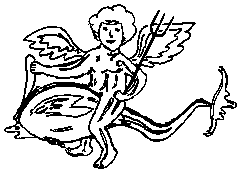 |
First Year Trip To Fishbourne

On Wednesday, July 7th, at 9.20 a.m. the first year boarded two coaches for Fishbourne, stopping
on the way at "The Wooden Bridge", Guildford (where Sinclair had a long telephone conversation
with someone) for refreshments at about 11.00 a.m. From the school to "The Wooden Bridge" was
quite uneventful; the wayside was lightly forested and the route lay through Chiswick. Arriving
at Fishbourne at 12.30 p.m., we had a picnic lunch and then went to see the palace. |

This is full of mosaics built at various times between the first and third centuries A.D. The
black and white ones with geometric patterns were the first to be laid at various times in the
second half of the first century when the original villa was expanded under its owner to the
size of a palace. The archaeologists have suggested that this man was Cogidubnus, a Briton, who
gave the Romans a great deal of help in their conquest of his native land. The coloured or
polychrome ones were built from the second century on: the "Boy on the Dolphin" and the "Medusa"
are two outstanding examples of these. These mosaics were planned very carefully, but some had
sunk because of the bad placing of the drainage system or a stream running under them causing
the foundations to subside. Some had black stains on them; this was because they had suffered
damage from fire.
Next the party visited the garden. To show where pillars used to be there were circular marks.
Through the middle of the garden there was a path with a hedge with rectangular or semi-circular
recesses which had once contained garden ornaments or seats. As we entered the garden we saw a
grassy bank at the far end. Under this, we learnt, there are more mosaics which have been
covered temporarily until the archaeological society can raise the funds to put them under
shelter to protect them from the rain.
We then had a look at a corridor with a semi-circular apse at one end where it is thought the
master of the house took his exercise in bad weather under cover: a similar long wide corridor
with semi-circular ends exists in a Roman imperial palace. On dry or sunny days the master took
his exercise in the garden. This corridor was most interesting and here we saw an example of
stucco or painted plaster.
After this we visited the museum. Among other interesting exhibits we saw the broken head of a
boy carved out of marble, a skeleton, and slides of mosaics and coins. The bookshop was also
very good and quite cheap.
We found our day's excursion to Fishbourne very interesting and informative and it was a
pleasure for all to go there.
D. Taylor 1H 1970-71

| 1971 Magazine Index
| HOME |

